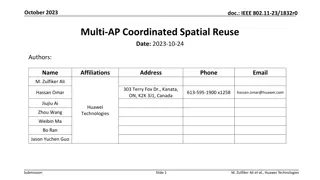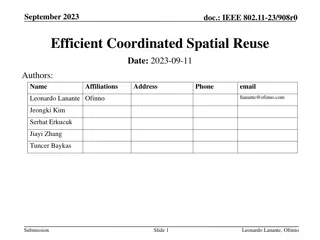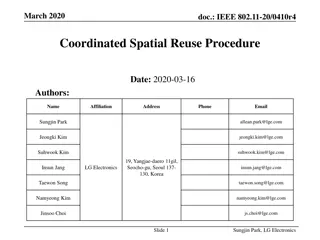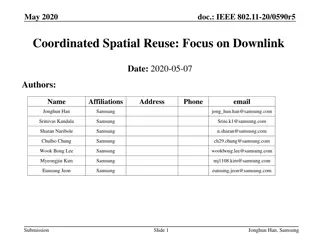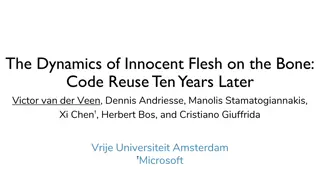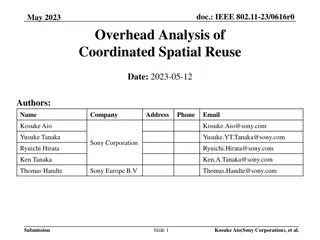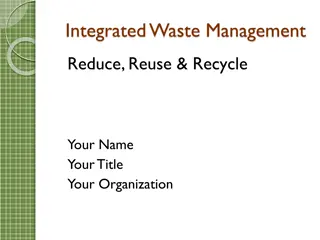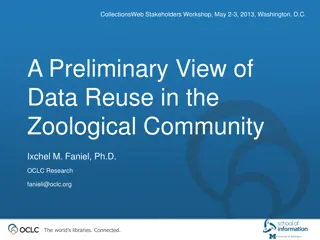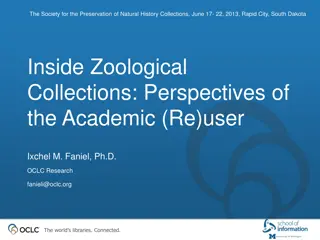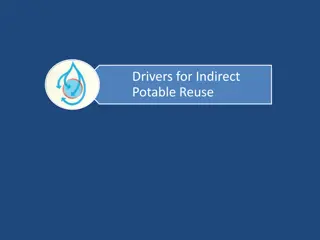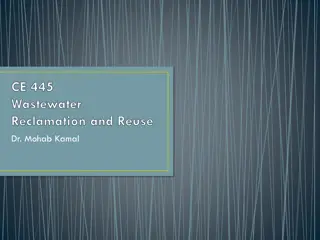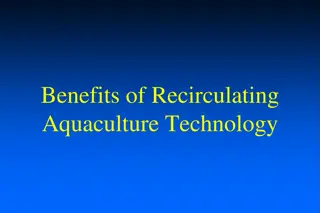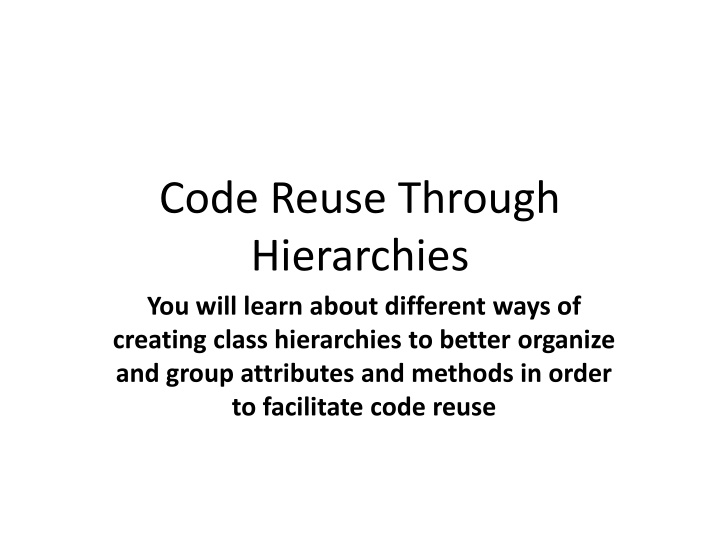
Creating Class Hierarchies for Efficient Code Reuse
Learn about different ways to organize class hierarchies for effective code reuse, including association and inheritance relationships. Discover how commonalities between classes can be leveraged through inheritance to avoid redundant code.
Download Presentation

Please find below an Image/Link to download the presentation.
The content on the website is provided AS IS for your information and personal use only. It may not be sold, licensed, or shared on other websites without obtaining consent from the author. If you encounter any issues during the download, it is possible that the publisher has removed the file from their server.
You are allowed to download the files provided on this website for personal or commercial use, subject to the condition that they are used lawfully. All files are the property of their respective owners.
The content on the website is provided AS IS for your information and personal use only. It may not be sold, licensed, or shared on other websites without obtaining consent from the author.
E N D
Presentation Transcript
Code Reuse Through Hierarchies You will learn about different ways of creating class hierarchies to better organize and group attributes and methods in order to facilitate code reuse
Review: Association Relation Between Classes One type of association relationship is a has-a relation (also known as aggregation ). E.g. 1, A car <has-a> engine. E.g. 2, A lecture <has-a> student. Typically this type of relationship exists between classes when a class is an attribute of another class. public class Car { private Engine anEngine; private Lights carLights; public start () { anEngine.ignite (); carLight.turnOn (); } } public class Engine { public boolean ignite () { .. } } public class Lights { private boolean isOn; public void turnOn () { isOn = true;} }
A New Type Of Association: Is-A (Inheritance) An inheritance relation exists between two classes if one class is a more specific variant type of another class Vehicle Motorcycle Car Bus Full sized SUV Sports car Mini
What If There Are Commonalities Between Classes Examples: All birds fly Some types of animals swim : fish, penguins, some snakes, crocodiles, some birds All animals eat , drink , sleep etc. Under the current approach you would have the same behaviors repeated over and over! Lion Hawk King Penguin eat() eat() eat() sleep() sleep() sleep() drink() drink() drink() Waste! Waste! Waste! James Tam
New Technique: Inheritance When designing an Object-Oriented program, look for common behaviors and attributes E.g., color, species, eat(), drink(), sleep() These commonalities are defined in a parent class Animal color species eat() sleep() drink() James Tam
New Technique : Inheritance (2) These commonalities are defined in a parent class As appropriate other child classes will directly include or inherit all the non-private attributes and behaviors of the parent class. Privates are still accessible through public methods. Animal color species eat() sleep() drink() King Penguin Lion Hawk James Tam
Defining A Class That Inherits From Another Format: public class <Name of child class> extends <Name of parent class> { // Definition of child class only what is unique to // this class } This means that a Lion object AUTOMATICALLY has all the capabilities of an Animal object Example: public class Lion extends Animal { public void roar() { System.out.println("Rawr!"); } } The only attributes and methods that need to be specified are the ones unique to a lion
First Inheritance Example Location of the full online example: /home/219/examples/hierarchies/1basicExample James Tam
Class Person public class Person { public static final long DELAY_TIME = 1999999999; Image of James Tam curtesy of James Tam private void delayTime() { for (long i = 0; i <= DELAY_TIME; i++); } public void doDailyTasks() { System.out.println("I am sleeping: zzzZZZZzzz"); delayTime(); System.out.println("I am eating: yum! yum! yum!"); delayTime(); System.out.println("I am drinking: hic, hic, hic"); delayTime(); System.out.println("I am execrating: :P :P :P"); } } James Tam
Class Person: Private Method public class Person { public static final long DELAY_TIME = 1999999999; Helper methods, only called internally, are often set to private private void delayTime() { for (long i = 0; i <= DELAY_TIME; i++); } public void doDailyTasks() { System.out.println("I am sleeping: zzzZZZZzzz"); delayTime(); System.out.println("I am eating: yum! yum! yum!"); delayTime(); System.out.println("I am drinking: hic, hic, hic"); delayTime(); System.out.println("I am execrating: :P :P :P"); } } James Tam
Class Hero: It Is A Person public class Hero extends Person { This automatically gives instances of this class all the capabilities of an instance of class Person } James Tam
Class Hero: A Person But A Whole Lot More public class Hero extends Person { private int heroicCount; public Hero() { heroicCount = 0; } Image of super James Tam curtesy of James Tam public void doHeroStuff() { System.out.println("I AM SAVING THE DAY FOR: TRUTH! JUSTICE!...AND ALL THAT GOOD STUFF!!!"); heroicCount++; } public int getHeroicCount() { return(heroicCount); } } James Tam
The Driver Class: Person Vs. Hero public class Driver { public static void main(String [] args) { Person bob = new Person(); bob.doDailyTasks(); System.out.println(); Hero clark = new Hero(); clark.doDailyTasks(); clark.doHeroStuff(); } } James Tam
Benefit Of Employing Inheritance Code reuse: The common and accessible attributes and methods of the parent will automatically be available in all the children. Person +doDailyTasks() Hero Accountant Teacher James Tam
New Terminology: Method Overriding Overriding occurs when the child class has a different version of a method than was implemented in the parent. Person +doDailyTasks() Hero +doDailyTasks() James Tam
Method Overriding Example Location of the complete example: /home/219/examples/hierarchies/2overriding Person +doDailyTasks() Hero +doDailyTasks() James Tam
Class Hero public class Hero extends Person { // New method: the rest of the class is the same as the // previous version public void doDailyTasks() { System.out.println("Pffff I need not go about mundane nicities such as eating!"); } } James Tam
The Driver Class (Included For Reference) public class Driver { public static void main(String [] args) { Person bob = new Person(); bob.doDailyTasks(); System.out.println(); Hero clark = new Hero(); clark.doDailyTasks(); clark.doHeroStuff(); } } James Tam
Overriding: The Type Of The Reference Determines The Method public class Person { public void doDailyTasks() { ... } } public class Hero extends Person { public void doDailyTasks() { ... } } // Bob is a Person bob.doDailyTasks(); // Clarke is a Hero clark.doDailyTasks(); James Tam
New Terminology: Polymorphism Poly = many Morphic = forms A polymorphic method is a method that has an implementation in the parent class and a different implementation the child class. Polymorphism: the specific method called will be automatically be determined without any type checking needed. Recall the example: James Tam
New Terminology: Super-class Vs. Sub-class Superclass (Button) All people on the earth (Superset Bigger) All people Subclass (RadioButton) in Canada (Subset - smaller) James Tam
Inheritance Is A One Way Relationship! A Hero is a Person but a Person is not a Hero! That means that while the sub-class can access the super-class but the super-class cannot access the sub-class New class New attributes New behaviors Existing class Attributes Behaviors James Tam
The Super Keyword Used to access the parts of the super-class. Format: <super>.<method or attribute> Example: System.out.println("Pffff I need not go about mundane nicities such as eating!"); System.out.println("...well actually I do..."); super.doDailyTasks(); } public void doDailyTasks() { Parent s version of method James Tam
Super Keyword: When Its Needed You only need this keyword when accessing non-unique methods or attributes (exist in both the super and sub-classes). Person For a Hero access super class method (use super ) super.doDailyTasks() +doDailyTasks() Hero For a Hero access this classes version (no super keyword) doDailyTasks() +doDailyTasks() Without the super keyword then the sub-class will be accessed James Tam
Super Keyword: When Its Not Needed If that method or attribute exists in only one class definition then there is no ambiguity. Person For a Hero doDailyTasks() +doDailyTasks() Hero For a Hero doHeroStuff() +doHeroStuff () James Tam
Something Especially Good? Note: There Is No Super.Super In Java James Tam
Calling The Super Class Constructor: Just Super() This results in a call to the super classes constructor (Useful for initializing the attributes that are defined in the super class) James Tam
Calling The Super Class Constructor Location of the full example: /home/219/examples/hierarchies/3superConstructors James Tam
Class Person public class Person { private int age; public Person() { age = 0; } public Person(int anAge) { age = anAge; } public int getAge() { return(age); } James Tam
Class Person (2) public String toString() { String s = ""; s = s + "Age of person: " + age + "\n"; return(s); } } James Tam
Class Hero: Using Super() public class Hero extends Person { private int heroicCount; public Person() { age = 0; } public Hero() { super(); heroicCount = 0; } public Person(int anAge) { age = anAge; } public Hero(int anAge) { super(anAge); heroicCount = 0; } public void doHeroStuff() { heroicCount++; } James Tam
Class Hero (2): Using Super() public String toString() public int getHeroicCount() { return(heroicCount); } { String s = ""; s = s + "Age of person: " + age + "\n"; return(s); public String toString () { String s = super.toString(); if (s != null) { s = s + "Count of brave and heroic deeds: " + heroicCount + "\n"; } return(s); } } } James Tam
The Driver Class public class Driver { public static void main(String [] args) { Hero clark = new Hero(); Hero peter = new Hero(17); System.out.println(clark); System.out.println(peter); } } public Person() { age = 0; } public Person(int anAge) { age = anAge; } James Tam
Access Modifiers And Inheritance Private - : still works as-is, private attributes and methods can only be accessed within that classes methods. Child classes, similar to other classes must access private attributes through public methods. Public + : still works as-is, public attributes and methods can be accessed anywhere. New level of access, Protected # : can access the method or attribute in the class or its sub-classes. James Tam
Summary: Levels Of Access Permissions Accessible to Access level Same class Subclass Not a subclass Public Yes Yes Yes Protected Yes Yes No Private Yes No No
Levels Of Access Permission: An Example public class P { private int num1; protected int num2; public int num3; // Can access num1, num2 & num3 here. } public class C extends P { // Can t access num1 here // Can access num2, num3 } public class Driver { // Can t access num1 here and generally can t access num2 here // Can access num3 here }
General Rules Of Thumb Variable attributes should not have protected access but instead should be private. Most methods should be public. Methods that are used only by the parent and child classes should be made protected.
Updated Scoping Rules When referring to an identifier in a method of a class 1. Look in the local memory space for that method 2. Look in the definition of the class 3. Look in the definition of the classes parent
Updated Scoping Rules (2) public class P { <<< Third: Parent s attribute >>> } public class C extends P { <<< Second: Attribute>>> Similar to how local variables can shadow attributes, the child attributes can shadow parent attributes. public void method () { <<< First: Local >>> Reference to an identifier e.g., num } }
Updated Scoping Rules: A Trace Location of the full online example: /home/219/examples/hierarchies/4scope James Tam
Parent: Class P public class P { protected int x = 1; protected int a = 2; public void method1() { System.out.println("P.method1()"); System.out.println("x/a: " + x + " " + a); } public void method2() { int a = 3; System.out.println("P.method2()"); System.out.println("x/a: " + x + " " + a); } } James Tam
Child: Class C public class C extends P { private int x = 3; private int y = 4; public void method1() { System.out.println("C.method1()"); int z = 5; int x = 6; System.out.println("x/y/z/a: " + x + " " + y + " " + z + " " + a); } } James Tam
The Driver Class public class Driver { public static void main(String [] args) { // Case 1 P p = new P(); p.method1(); p.method2(); // Case 2 C c = new C(); c.method1(); // Case 3 // Case 4 c.method2(); } } James Tam
Case 1 class P { protected int x = 1; protected int a = 2; public void method1() { System.out.println("P.method1()"); System.out.println("x/a: " + x + " " + a); } James Tam
Case 2 class P { protected int x = 1; protected int a = 2; public void method2() { int a = 3; System.out.println("P.method2()"); System.out.println("x/a: " + x + " " + a); } } James Tam
Case 3 class P { protected int x = 1; protected int a = 2; } public class C extends P { private int x = 3; private int y = 4; public void method1() { System.out.println("C.method1()"); int z = 5; int x = 6; System.out.println("x/y/z/a: " + x + " " + y + " " + z + " " + a); } } James Tam
Case 4: Just Call The Parent, No Child class P { protected int x = 1; protected int a = 2; public void method1() { } public void method2() { int a = 3; System.out.println("P.method2()"); System.out.println("x/a: " + x + " " + a); } } public class C extends P { private int x = 3; private int y = 4; public void method1() { } } c.method2(); James Tam
The Final Modifier (Inheritance) What you know: the keyword final means unchanging (used in conjunction with the declaration of constants) Methods preceded by the final modifier cannot be overridden e.g., public final void displayTwo () Classes preceded by the final modifier cannot be extended e.g., final public class ParentFoo
Reminder: Casting The casting operator can be used to convert between types. Format: <Variable name> = (type to convert to) <Variable name>; Example (casting needed: going from more to less) double full_amount = 1.9; int dollars = (int) full_amount; Example (casting not needed: going from less to more) int dollars = 2; double full_amount = dollars;



